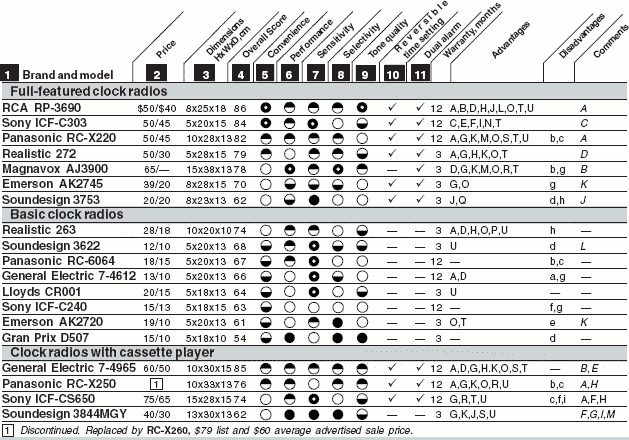
Clock radios
Listed by types; within types, listed in order of overall score. Differences in score of 4 points or less were not deemed significant.
1 Brand and model. If you can't find a model, call the company. Phone numbers are listed on page 736.
2 Price. The manufacturer's suggested or approximate retail price, followed by the average advertised price.
3 Dimensions. To the nearest centimetre.
4 Overall score. A composite, encompassing all our tests and judgments. A "perfect" radio would have earned 100 points.
5 Convenience. This composite judgment reflects such things as the legibility of the display, the ease of tuning the radio and setting the alarm, and the presence or absence of useful features.
6 Performance. An overall judgment reflecting performance in our tests of: sensitivity and selectivity; tuning ease; capture ratio, the ability to bring in the stronger of two stations on the same frequency; image rejection, the ability to ignore signals from just above the band, resistance to interference from signals bouncing off aircraft and such.
7 Sensitivity. How well each radio received a station with little interference.
8 Selectivity. How well each radio received clearly a weak station next to a strong one on the dial.
9 Tone quality. Based mainly on computer analysis of the speaker's output and on listening tests, using music from CDs. No model produced high-fidelity sound.
10 Reversible time-setting. This useful feature makes setting clock and alarm times easy. If you overshoot the desired setting, you simply back up.
11 Dual alarm. Lets you set two separate wake-up times.

All: •Permit snooze time of about 8 min. •Retain time settings during short power failures.
Except as noted, all have: •Battery backup for clock and alarm memory. •Red display digits 1 cm. high. •Sleep-time radio play for up to 60 min. before automatic shutoff. •Switch to reset alarm.
Keys to Advantages
A — Alarm works despite power failure.
B — Shows actual time plus up to 2 alarm times.
C — Twin alarms settable for 2 different stations.
D — Tone alarm has adjustable volume control.
E — Memory needs no battery.
F — Digital tuner with presettable stations.
G — Tuner can receive in stereo.
H — Battery-strength indicator.
I — Illuminated tuning dial.
J — Illuminated tuning pointer.
K — Earphone jack.
M — Audio input for tape deck or CD player.
N — Display can show date and time.
O — Display has high/low brightness switch.
P — Display has larger digits than most.
Q — Night light—adjusts for room light.
R — Bass-boost tone control.
S — Treble-cut tone control.
T — Better than most in tuning ease.
U — Better than most in image rejection.
Key to Disadvantages
a — Possible to reset time by accident.
b — Controls for time-setting or dimmer inconveniently located on radio's bottom or rear.
c — Display dimmer than most in brightly lit room.
d — Radio volume must be turned completely down for alarm buzzer to sound.
e — Lacks alarm buzzer; radio is sole alarm.
f — Lacks indication alarm is set.
h — Time-setting lacks fast reverse.
i — No slow forward, fast reverse for time setting.
Key to Comments
A — Display shows green digits.
B — Display shows blue digits.
C — Display uses LCD (liquid crystal) digits.
D — Terminals for external antenna.
E — 3-position graphic equalizer.
F — Cassette player lacks Record function.
G — Cassette player lacks Rewind function.
H — Model permits wake-up to cassette play.
I — Cassette-deck flutter worse than most.
J — Warranty repairs cost $3 for handling.
K — Warranty repairs cost $3.50 for handling.
L — Warranty repairs cost $6 for handling.
M — Warranty repairs cost $10 for handling.